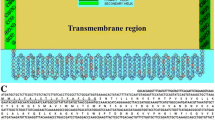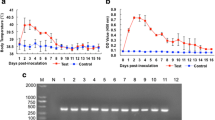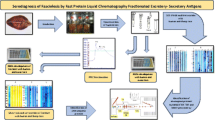Abstract
Merozoites of fourBabesia canis isolates from Hungary, France, Africa, and Egypt were purified. Antigens were compared in an enzyme-linked immunosorbent assay (ELISA) and by immunoblotting. In the ELISA, antigen from the highly pathogenic isolate from Hungary showed the highest sensitivity for homologous and heterologous immune sera. This was confirmed by immunoblotting. Protein bands of the Hungarian isolate were strongly recognized by allB. canis immune sera, whereas the antigens from the other isolates showed only weak reactions with homologous and heterologous immune sera. Significant was a protein band of about 12 kDa appearing in all pathogenic isolates from Hungary, France, and South Africa but not in the apathogenic Egyptian isolate. This protein band may determine the virulence. For serological tests, theB. canis isolate from Hungary seems to be the one most suitable for detection of even mild infections.
Similar content being viewed by others
References
Azzard G, Radisson J, Got R (1990) Characterization and purification of culture-derived soluble glycoproteins ofBabesia canis. Parasitol Res 76:578–580
Bradford MM (1976) A rapid and sensitive method for the quantitation of microgram quantities of protein using the principle of dye binding. Anal Biochem 72:248–254
Bushan C, Müller I, Friedhoff KT (1991) Enrichment ofBabesia caballi-infected erythrocytes from microaerophilous stationary-phase cultures using Percoll gradients. Parasitol Res 77:177–179
Gothe R, Wegerdt S, Walden R, Walden A (1989) On the epidemiology of infections withBabesia canis andBabesia bibsoni in dogs in Germany. Kleintierpraxis 34:309–322
Hauschild S, Schein E (1992) Specific transmission ofBabesia canis by different tick species. Zentralbl Bakteriol Mikrobiol Hyg [A] 325:35–36
Kahl LP, Anders RF, Rodwell BJ, Timms P, Mitchel GF (1982) Variable and common antigens ofBabesia bovis parasites differing in strain and virulence. J Immunol 129:1700–1705
Laemmli UK (1970) Cleavage of structural proteins during the assembly of the head of bacteriophage T4. Nature 227:680–685
Maegraith B, Gilles HM, Devakul K (1957) Pathological processes inBabesia canis infections. Trop Med Parasitol 8:485–514
Richards WHG, Williams SG (1973) The removal of leucocytes from malaria-infected blood. Ann Trop Med Parasitol 67:249–250
Sugimoto C, Sato M, Kawazu S, Kamoi T, Fujisaki K (1991) Purification of merozoites ofTheileria sergenti from infected bovine erythrocytes. Parasitol Res 77:129–131
Uilenberg G, Top PDJ Arends PJ, Dijk JE van, Schieveen PBE van, Zwart D (1985) Autochtone Babesiosis bij, de hond in Nederland? Tijdschr Diergeneeskd 110:93–98
Uilenberg G, Franssen FFJ, Periè NM, Spanjer AAM (1989) Three groups ofBabesia canis distinguished and a proposal for nomenclature. Vet Q 11:33–40
Author information
Authors and Affiliations
Rights and permissions
About this article
Cite this article
Hauschild, S., Shayan, P. & Schein, E. Characterization and comparison of merozoite antigens of differentBabesia canis isolates by serological and immunological investigations. Parasitol Res 81, 638–642 (1995). https://doi.org/10.1007/BF00931839
Received:
Accepted:
Issue Date:
DOI: https://doi.org/10.1007/BF00931839




